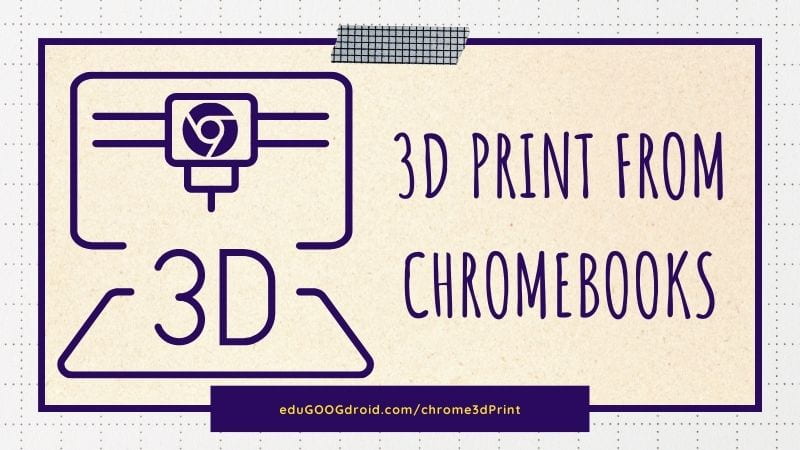From design to final product, students can use Chromebooks in the classroom to 3D print. This post will show how to start designing from a Chromebook and finalizing on a 3D printer without a second computer. This post, however, will not cover how to use a 3D printer since each is different.
For explorers that need the tools without explanations, scroll down to, “How do I 3D Print from a Chromebook?”
The Chromebook.
There are two primary tools needed for 3D printing: a design tool and a slicer. The purpose of the slicer is to tell the 3D printer where it will place each line and layer of plastic. Most 3D printers will understand slicing instructions known as “gcode.”
All tools will need to be web-based since we will use Chromebooks. However, not many 3D printers support Chromebooks. Nevertheless, many 3D printers support removable storage, for example, MicroSD.
The Design Tool.
We will use Tinkercad as the web-based 3D design tool. The website will require registration to join. Although there are options for a classroom setting, the fastest way to create an account is to create a personal account. This website can use Google’s SSO to register and sign in quickly, which benefits schools with Google Workspace for Education.

This post will not cover how to use this tool. However, the website does have a self-paced learning platform. On the top right, select Learn.
The Slicer.
We will use AstroPrint as the web-based 3D slicer tool. This website can use Google’s SSO to sign in quickly, which benefits schools with Google Workspace for Education. The first time anyone logs in, the site will ask for a device to use or purchase; select “I will choose later.”

The limitations are that only two printers are allowed, and up to 1GB of data can be stored. However, each student with a Google for Education account can create their profile.
Once logged in, scroll down to “PRINTING PROFILES” and select “Printer Profiles.” Most popular printers are available. After setting up the printer, set up the “Material Profiles.” By default, the website only has ABS and PLA.
From Design to Slice.
This post will not cover the advanced printing settings since the basic settings will work for most print jobs and printers. First, complete the design on Tinkercad. Then, do the following:
- Select Export on the top-right,
- Select the 3D Print tab,
- Select AstroPrint,
- Under the “Leaving Tinkercad” section, select Continue to Astroprint,
- If required, sign in.
- If there are subfolders under the Design Library, select the correct folder,
- Otherwise, select Import,
- Select “Print/Slice,”
- Verify that the correct printer and material is selected,
- Some designs will require printing supports; check the box if needed,
- Select slice,
- Open the STL file,
- Find the corresponding GCODE file,
- Click on the right three dots (ellipsis) and select Download,
- Move the downloaded file to the MicroSD card,
- Insert the MicroSD card into the printer and print.
Other Tools.
Create a lithophane.
Lithophanes are 2D photos that are carvings or 3D image versions. Use the 3dp.rocks website to create lithophanes. Start by clicking on the Image tab at the top.
Some images may need to be inverted horizontally depending on the resulting 3D print. The FlipAPicture.com website does that. Make any other changes in Tinkercad.
Ready to Print Designs.
Thingiverse is a magnificent website to find designs that are ready to print. Bring the design to Tinkercad for some modifications.
Funding.
DonorsChoose lets educators share their classroom needs with a thriving community eager to help. Supporters have brought teachers’ ideas to life in more than half of all U.S. public schools.
Summary.
How do I 3D Print from a Chromebook?
You will need three devices:
- A Chromebook,
- A 3D Printer, and
- A compatible SD Card.
You will need these web resources:
- Tinkercad for design.
- Astroprint to slice.
- 3dp.rocks to create Lithophanes.
- Thingiverse for designs ready to print.
- DonorsChoose to fund your devices if you do not have them yet.


